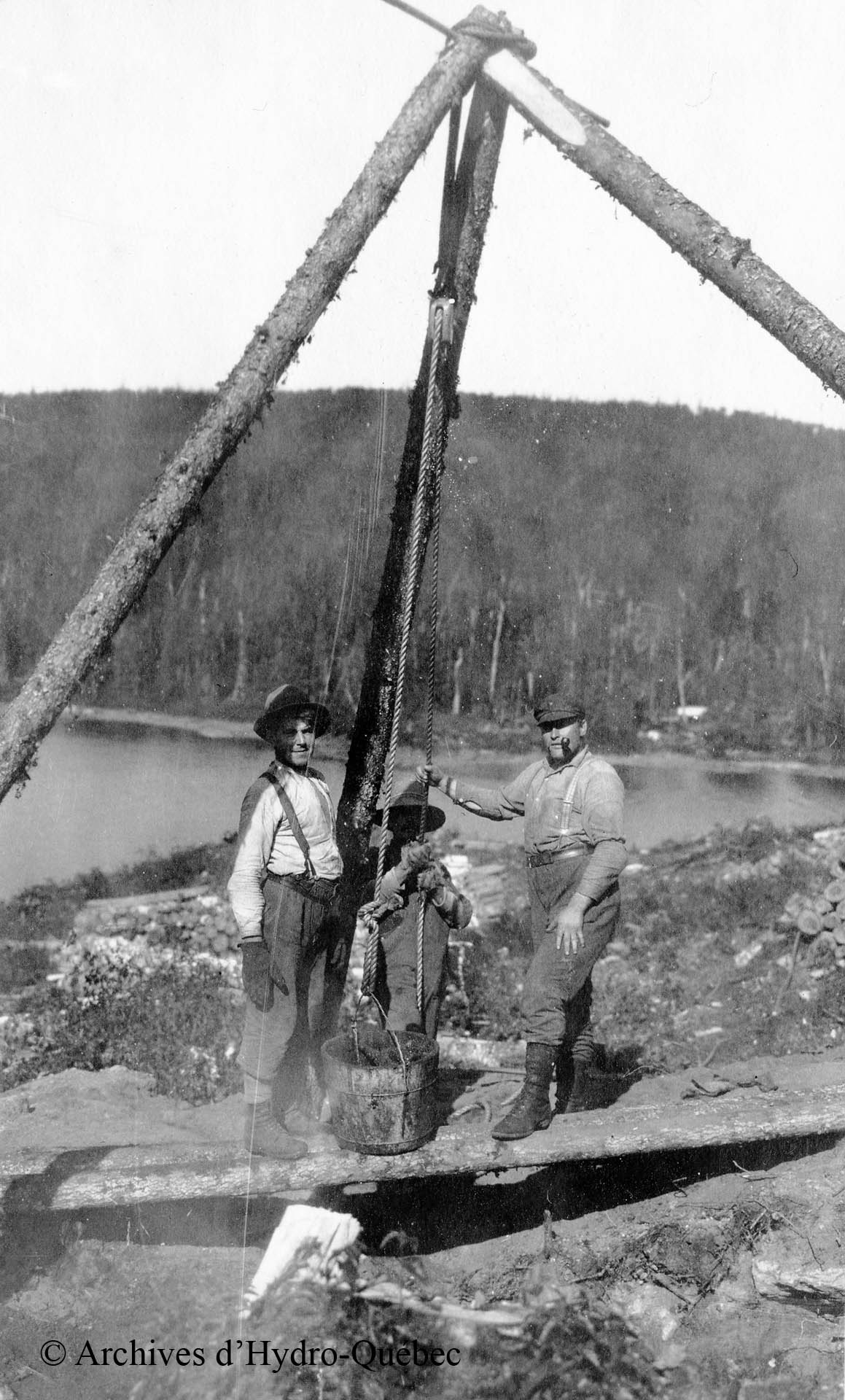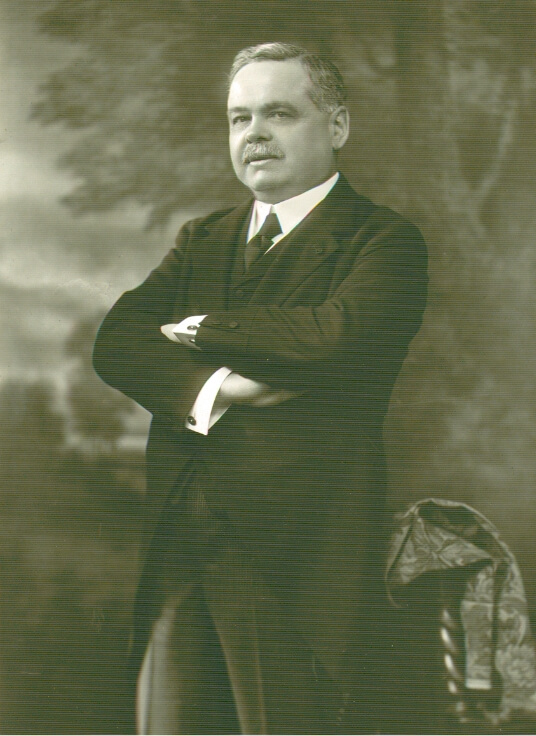A vast undertaking
In September 1916, the construction of Gouin dam was started. It was a huge challenge at the time, comparable to that carried out on the Manicouagan and in Baie-James decades later.
Although the team had state-of-the-art equipment, the location was remote. It was also the height of the First World War and, with the war effort and conscription of soldiers, labor was in short supply. The construction of the dam was completed in December 1917, one month ahead of schedule. At the time it was commissioned, it was the biggest construction project ever completed in Québec and it created the largest reservoir in the world. The dam has since come to be known as the guardian of the Rivière Saint-Maurice.

The builders
The
Québec Streams Commission![]() [information in French only] was mandated to build a dam to regulate the rushing waters of the Rivière Saint-Maurice. Based on information provided by the Saint-Maurice Hydraulic
Company, a subsidiary of the
Shawinigan Water and Power Company specialized in construction,
the Commission completed preliminary studies and launched a call for tenders. The Saint-Maurice Construction Company was awarded the contract in 1915 and teamed up
with the Fraser Brace Company, with whom it had just completed the construction of the Les Cèdres generating station
[information in French only] was mandated to build a dam to regulate the rushing waters of the Rivière Saint-Maurice. Based on information provided by the Saint-Maurice Hydraulic
Company, a subsidiary of the
Shawinigan Water and Power Company specialized in construction,
the Commission completed preliminary studies and launched a call for tenders. The Saint-Maurice Construction Company was awarded the contract in 1915 and teamed up
with the Fraser Brace Company, with whom it had just completed the construction of the Les Cèdres generating station![]() [information in French only], in Montérégie. The companies would face several technical challenges along the way.
[information in French only], in Montérégie. The companies would face several technical challenges along the way.
Building in the middle of a forest
The main challenge was access to the construction site. Thirty-one barges were used to travel dozens of kilometres up the river to the Chaudière rapids. There were so many rapids that in the fall of 1915 they were forced to build a 30-kilometre railroad along the river bank. It took close to 900 men and 65 horses to install the railroad. Oil-fired locomotives were used to prevent forest fires caused by flying cinders. A fire would damage the building materials and could even endanger the lives of workers on the site.


Workcamps
Prior to the construction of the dam, separate workcamps were built on either side of the Saint-Maurice for employees of the Québec Streams Commission and the workers of the Saint-Maurice Hydraulic Company. On the right bank, a temporary village was built to house a maximum of 560 residents. In July 1917, 463 people were working on the site. Non-specialized workers earned 20 ents an hour plus room and board.

Impact of the First World War
The First World War![]() lasted from 1914 to 1918. Canada entered into the war at the same time as Great Britain and joined the war effort on the home front
lasted from 1914 to 1918. Canada entered into the war at the same time as Great Britain and joined the war effort on the home front![]() , supporting the allies by providing materials and labor. There was not enough manpower for the Gouin dam construction site, in operation from 1915 to 1917. The Saint-Maurice Construction
Company therefore decided to hire recent immigrants who could not go to the front because of their citizenship. When the labour shortage worsened, the company hired prisoners to work on the site.
, supporting the allies by providing materials and labor. There was not enough manpower for the Gouin dam construction site, in operation from 1915 to 1917. The Saint-Maurice Construction
Company therefore decided to hire recent immigrants who could not go to the front because of their citizenship. When the labour shortage worsened, the company hired prisoners to work on the site.

High-tech equipment
One of the biggest innovations on the Gouin dam construction site was an 80-kilometre telephone line connecting the site to the Sanmaur terminal. This line permitted contact with the rest of the region, despite the site’s remote location. The Commission could now communicate at all times with the construction team and transmit instructions.

To meet electricity needs, a hydroelectric generating station was built on the Loutre rapids, some five kilometres downstream of the site. Two 350-kW horizontal axis generating units were installed to power equipment, including the crusher, concrete mixer, shop machinery, pumps, and lighting and heating systems in the buildings. These turbine-generator units are on display at the NAC.

Geology does its part
The foundation of Gouin dam is Laurentian gneiss![]() .
This rock, which makes up the Canadian Shield, is between 1 and 1.7 billion years old. Given the solidity and stability of the dam’s foundation,
experts in 1915 determined there would be no risk of water infiltration.
.
This rock, which makes up the Canadian Shield, is between 1 and 1.7 billion years old. Given the solidity and stability of the dam’s foundation,
experts in 1915 determined there would be no risk of water infiltration.

Cyclopean concrete
In 1913, based on studies at the time, the engineers opted to build a concrete gravity dam. Given the remote location of the site, they recommended using cyclopean concrete, which is mixed with rocks. This type of concrete was popular in the late 19th and early 20th centuries, because it requires less cement, which was costly at the time. The solution seemed a wise choice for the Gouin dam project, since the cement had to be transported all the way from Montréal.


Log chutes
Up until 1958, Gouin dam had a log running system. It played an important role in the 1910s, but later fell into disuse. Prior to 1996, the Rivière Saint-Maurice was the main way to get logs to the pulp and paper mills. To transfer the logs and prevent them from being damaged by the falls, log chutes were built into hydropower facilities. For more than 40 years, these chutes were included in dam construction plans in order to facilitate the work of log drivers. The chutes were used throughout the 20th century, but became obsolete when log driving was prohibited on Québec’s rivers. Logs are now transported by trucks.

The importance of a spillway
In 1958, instead of constructing a weir, they built a spillway. With its four deep gates, the spillway allows water to be controlled during the spring flood in a more efficient and flexible way than a weir, which prevents water from reaching levels that could put facility operation or the general public in jeopardy.


The ice factor
Engineers who design dams in Québec need to take winter ice into account. When the water in a dam is transformed into ice, it expands, exerting pressure on the river banks and on the dam. In spring, chunks of ice become detached and, propelled by the wind, can cause damage. Dams here therefore need a more solid construction to withstand the vagaries of winter.

Photo credit : Montminy et cie.
Naming a dam
The construction of Gouin dam was completed in December 1917, 26 days ahead of schedule. It was named Gouin dam in 1919, in honor of
Lomer Gouin![]() [information in French only],
the premier of Québec at the time. It was he who established the Québec Streams Commission and gave it its first mandate, namely to oversee the project to control the Rivière Saint-Maurice.
[information in French only],
the premier of Québec at the time. It was he who established the Québec Streams Commission and gave it its first mandate, namely to oversee the project to control the Rivière Saint-Maurice.
Today, 100 years later,
Gouin dam![]() [information in French only]
still controls the river’s tumultuous waters. This guardian of the Rivière Saint-Maurice is close to 500 metres long and up to 26 metres high.
[information in French only]
still controls the river’s tumultuous waters. This guardian of the Rivière Saint-Maurice is close to 500 metres long and up to 26 metres high.



